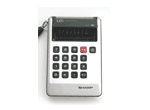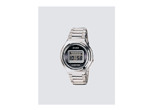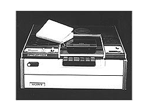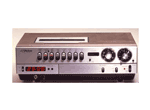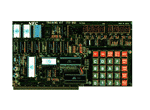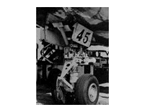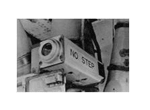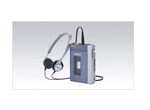Application Products
1970s
1973: World’s first liquid-crystal display (LCD) electronic calculator (Sharp)
After one and a half years of development, Sharp released the EL-805 electronic calculator, the first of a new “COS LCD” type. COS stands for “crystal-on-substrate” or “calculator-on-substrate”, meaning that all functions such as the display, circuits, and key contacts are integrated onto a single glass board.
The development of the EL-805 thus required a collection of extremely high-level technologies for the time. The EL-805 was a phenomenal hit as the first electronic calculator to adopt a COS LCD, which allowed the EL-805 to run for 100 hours on a single AA battery.
1974: The Casiotron electronic wristwatch goes on sale; production accelerates (Casio)
In November of 1974, Casio released the Casiotron digital wristwatch, featuring a fully automatic calendar function that automatically adjusts for the number of days in each month. By considering the watch as a counter of crystal-oscillator pulses or a simple adding machine for incrementation second by second, Seiko made the most of LSI technologies it had achieved through the development of electronic calculators.
1975: Release of color VCR machines (Sony and Victor Company of Japan)
The first model of Sony’s Betamax machine (SL-6300) was released on May 10th, 1975. While none of the earlier VCR formats had gained mass-market popularity, Betamax became a hit, launching the market for home-use VCRs and maintaining a reasonable share of this market in its initial stages.
The Victor Company of Japan (JVC) released the first VHS-format VCR machine (HR-3300) in October 1976. The list price of the HR-3300 was 256,000 yen. For a further 10,000 yen, JVC also provided an external timer for programmed recording as an optional accessory to be attached to the HR-3300. A VHS videocassette tape that was capable of recording 120 minutes cost 6,000 yen.
1975: The TK-80 training kit for developing microcomputer systems (NEC)
The Semiconductor Division of NEC Corporation (NEC) released the TK-80 on August 3rd, 1976. Since computer hobbyists liked how the TK-80 did not require an expensive terminal equipment, the TK-80 triggered a “microcomputer boom” that led to the trend of 8-bit computers (e.g. in Japan, the PC-8000 series from NEC, Basic Master from Hitachi, and MZ series from Sharp).
The CPU for the TK-80 was the PD8080A microprocessor from NEC (this was compatible with the 8080A from Intel). Other components included the PD454D 256-byte ROM and a 1-Kbit S-RAM.
1978: World’s first commercial CCD video camera, the XC-1 (Sony)
Sony announced commercialization of the world’s first two-chip color camera, the XC-1. The XC-1 received a massive public response when it was mounted on an All Nippon Airways (ANA) superjumbo jet (Boeing 747) for use in ANA's Sky Vision system.
July 1st, 1979: The Walkman portable stereo cassette player is a huge hit (Sony)
Sony released the Walkman on July 1st, 1979. This was a groundbreaking event in that the Walkman allowed people to listen to recorded music anywhere and at anytime. The Walkman was a worldwide phenomenon, and the trademark became synonymous with the words “headphone stereo”.


